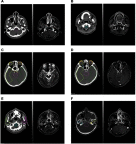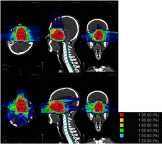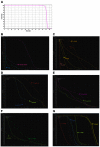Intensity-modulated carbon-ion radiation therapy versus intensity-modulated photon-based radiation therapy in locally recurrent nasopharyngeal carcinoma: a dosimetric comparison
- PMID: 31496819
- PMCID: PMC6701671
- DOI: 10.2147/CMAR.S205421
Intensity-modulated carbon-ion radiation therapy versus intensity-modulated photon-based radiation therapy in locally recurrent nasopharyngeal carcinoma: a dosimetric comparison
Abstract
Purpose: To identify the specific dose advantage of intensity-modulated carbon-ion radiation therapy (IMCT) over photon-based intensity-modulated radiation therapy (IMRT) in the treatment of locally recurrent nasopharyngeal carcinoma (NPC).
Materials and methods: Ten patients with locally recurrent NPC underwent IMCT and IMRT planning. Target definition followed the recommendations of the International Commission on Radiation Units and Measurements (ICRU) reports no. 50, 62 and 83. The real treatment plans which were delivered to patients were designed on the Siemens Syngo planning system while the control plans for dosimetric comparison were generated from the Varian Medical Systems. The optimization constraints of the two designs were basically the same. Target coverage was evaluated using the following parameters: Dmin, Dmax, D1, D2, D50, D95, D98 and D99. Target dose distribution and conformality were evaluated using the homogeneity index and conformity index. Normal tissue sparing of organs at risk (OARs) were evaluated using Dmean, D1 and Dmax. SPSS 22.0 software was used for data analysis.
Results: Both IMCT and IMRT plans met clinical prescription dose requirements. Target coverage of D1, D2, D50, D95, D98, D99 were not significantly different between the two plans (P>0.05). The two plans showed satisfactory coverage of the target without significant difference. There was no significant difference in terms of the homogeneity and conformability between the two plans. Dosimetric parameters for the brain stem, spinal cord, parotid gland, optic chiasm, eyeball, lens, temporal lobe and inner ear were significantly reduced in the IMCT plan (P<0.05).
Conclusion: As compared with photon-based IMRT, IMCT significantly reduces radiation dose to the OARs in the treatment of locally recurrent NPC while maintaining the dose coverage to the target volumes. Such a feature is particularly important for patients who experienced previous high-dose irradiation.
Keywords: carbon ion; dosimetry comparison; locally recurrent nasopharyngeal carcinoma.
Conflict of interest statement
Dr Lei Wang reports grants from Joint Breakthrough Project for New Frontier Technologies of the Shanghai Hospital Development Center (Project No. SHDC 12015118) and grants from Science and Technology Commission of Shanghai Municipality (Project Nos. 15411950102 and 15411950106), during the conduct of the study. The authors report no other conflicts of interest in this work.
Figures



Similar articles
-
Dosimetric comparison between 2-dimensional radiation therapy and intensity modulated radiation therapy in treatment of advanced T-stage nasopharyngeal carcinoma: to treat less or more in the planning organ-at-risk volume of the brainstem and spinal cord.Med Dosim. 2007 Winter;32(4):263-70. doi: 10.1016/j.meddos.2007.02.006. Med Dosim. 2007. PMID: 17980826
-
Determining appropriate timing of adaptive radiation therapy for nasopharyngeal carcinoma during intensity-modulated radiation therapy.Radiat Oncol. 2015 Sep 17;10:192. doi: 10.1186/s13014-015-0498-1. Radiat Oncol. 2015. PMID: 26377685 Free PMC article. Clinical Trial.
-
Dosimetric Comparisons of Volumetric Modulated Arc Therapy and Tomotherapy for Early T-Stage Nasopharyngeal Carcinoma.Biomed Res Int. 2018 Jun 4;2018:2653497. doi: 10.1155/2018/2653497. eCollection 2018. Biomed Res Int. 2018. PMID: 29967769 Free PMC article.
-
Robust optimization in lung treatment plans accounting for geometric uncertainty.J Appl Clin Med Phys. 2018 May;19(3):19-26. doi: 10.1002/acm2.12291. Epub 2018 Mar 10. J Appl Clin Med Phys. 2018. PMID: 29524301 Free PMC article. Review.
-
Proton versus Photon Radiotherapy for Pediatric Central Nervous System Malignancies: A Systematic Review and Meta-Analysis of Dosimetric Comparison Studies.J Oncol. 2019 Nov 27;2019:5879723. doi: 10.1155/2019/5879723. eCollection 2019. J Oncol. 2019. PMID: 31885580 Free PMC article. Review.
Cited by
-
Charged Particle Irradiation for Pancreatic Cancer: A Systematic Review of In Vitro Studies.Front Oncol. 2022 Jan 4;11:775597. doi: 10.3389/fonc.2021.775597. eCollection 2021. Front Oncol. 2022. PMID: 35059313 Free PMC article.
-
Particle beam therapy for nasopharyngeal cancer: A systematic review and meta-analysis.Clin Transl Radiat Oncol. 2022 Aug 23;37:41-56. doi: 10.1016/j.ctro.2022.08.011. eCollection 2022 Nov. Clin Transl Radiat Oncol. 2022. PMID: 36065359 Free PMC article. Review.
-
Clinical outcomes of particle beam radiation therapy for patients with newly-diagnosed major salivary gland tumors.BMC Cancer. 2025 Mar 13;25(1):452. doi: 10.1186/s12885-025-13846-1. BMC Cancer. 2025. PMID: 40082821 Free PMC article.
-
Treatment of Recurrent Nasopharyngeal Carcinoma: A Sequential Challenge.Cancers (Basel). 2022 Aug 25;14(17):4111. doi: 10.3390/cancers14174111. Cancers (Basel). 2022. PMID: 36077648 Free PMC article. Review.
-
Flourish of Proton and Carbon Ion Radiotherapy in China.Front Oncol. 2022 Feb 14;12:819905. doi: 10.3389/fonc.2022.819905. eCollection 2022. Front Oncol. 2022. PMID: 35237518 Free PMC article. Review.
References
LinkOut - more resources
Full Text Sources
Research Materials
Miscellaneous

